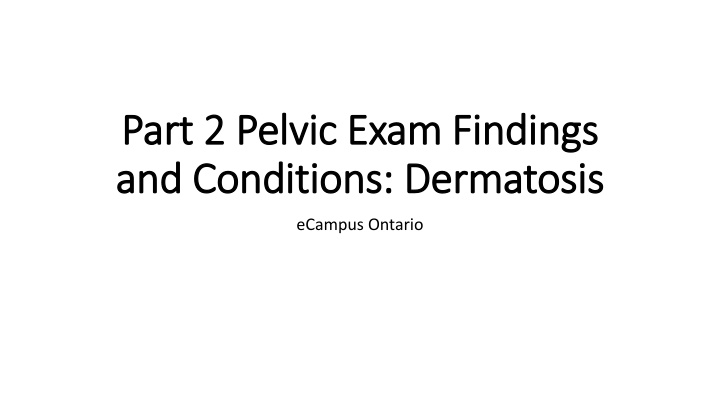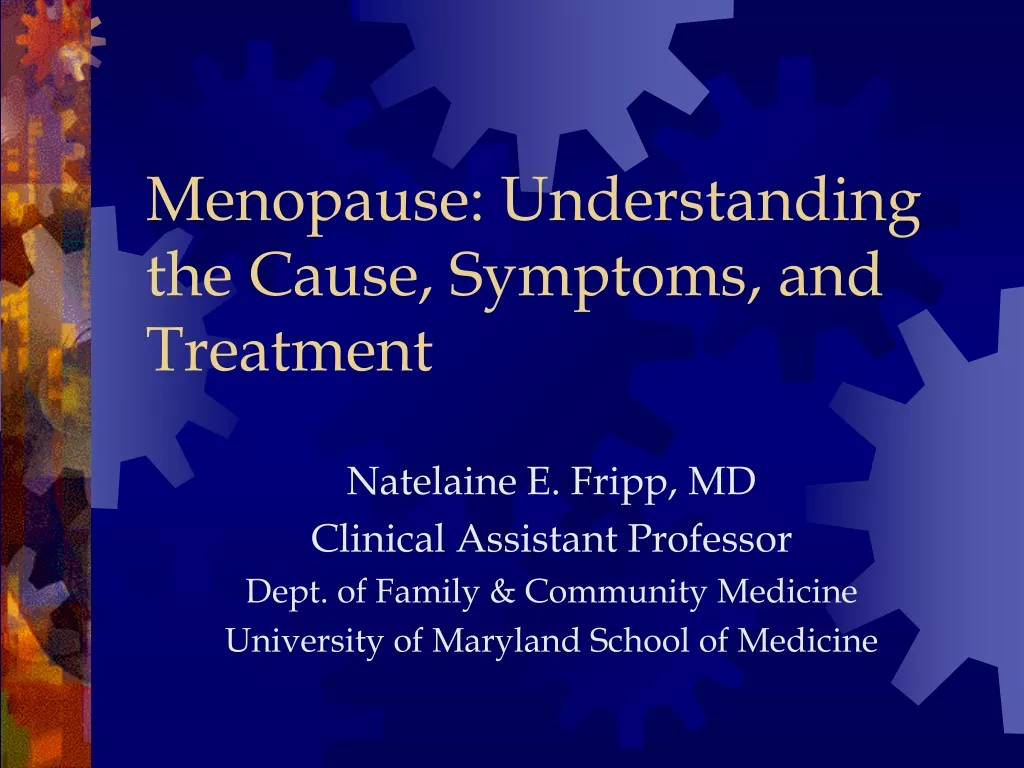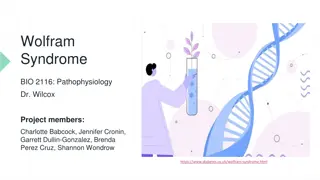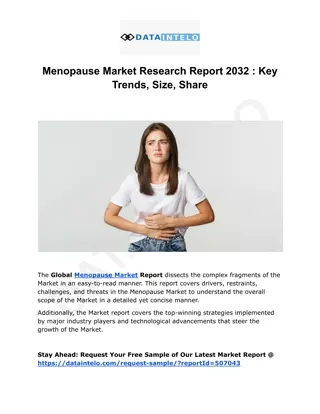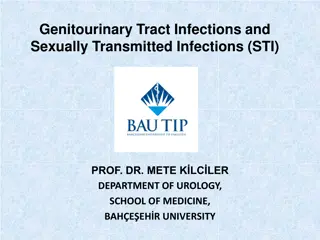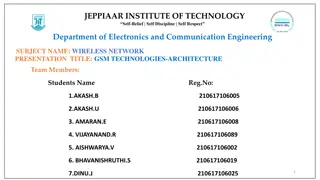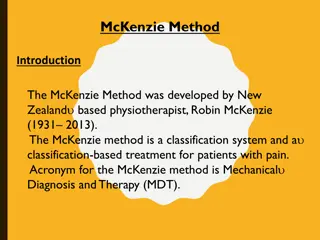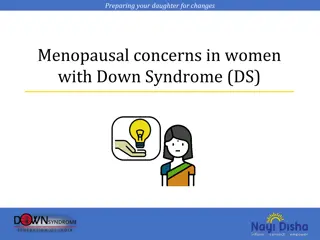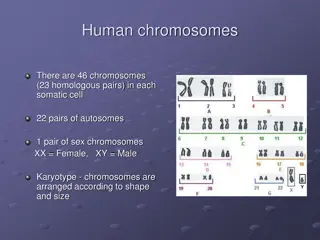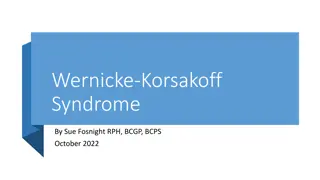Genitourinary Syndrome of Menopause (GSM) - Symptoms and Management Overview
Genitourinary syndrome of menopause (GSM) encompasses urovaginal symptoms associated with hormonal changes during menopause. Symptoms include vaginal dryness, burning, itching, dyspareunia, urinary urgency, and more. Thin, pale epithelium and tissue changes are common. Management involves various treatment options tailored to individual needs based on current evidence-based guidelines.
Download Presentation

Please find below an Image/Link to download the presentation.
The content on the website is provided AS IS for your information and personal use only. It may not be sold, licensed, or shared on other websites without obtaining consent from the author.If you encounter any issues during the download, it is possible that the publisher has removed the file from their server.
You are allowed to download the files provided on this website for personal or commercial use, subject to the condition that they are used lawfully. All files are the property of their respective owners.
The content on the website is provided AS IS for your information and personal use only. It may not be sold, licensed, or shared on other websites without obtaining consent from the author.
E N D
Presentation Transcript
Part 2 Pelvic Exam Findings Part 2 Pelvic Exam Findings and Conditions: Dermatosis and Conditions: Dermatosis eCampus Ontario
Part 2: Dermatosis Part 2: Dermatosis This portion of the presentation describes findings and conditions that may present on pelvic exam as dermatosis skin conditions of the vulvovaginal area. The clinical manifestations may include [but are not limited to] vulvovaginal: burning, itching, irritation, vaginal/vulvar adhesions, pain and/or pain with intercourse [dyspareunia]. NOTE: It is important to note that the lectures (and associated content) is current as of December 2021. For all treatment/management, it is essential that all practitioners consult the most recent evidence-based guidelines prior to initiating therapy. It is also recommended that for infectious conditions, that practitioners check the Public Health Agency of Canada or local province clinical guidelines/recommendations prior to initiating antimicrobial prescriptions and/or recommendations. This will ensure you have the most recent evidence-based treatment recommendations for infectious strains found in your area/region.
Content Content Part 2: Vulvovaginal Dermatosis Genitourinary syndrome of menopause (GSM) [previously: vulvovaginal atrophy] Part 1: Masses/Viral Lesions Vulvodynia/Vestibulitis/Vaginismus Vulvovaginal Contact Dermatitis soaps/creams/bubble bath/Vaginal medicines or douching. Subcutaneous Lesions: Folliculitis, Furuncle (boil), Carbuncle (abscess) Lichen Simplex Chronicus Bartholin s Cysts & Abscesses Lichen Sclerosus Herpes Simplex Virus [post herpetic neuralgia] Lichen Planus Genital Warts: Human Papilloma Virus, Molluscum Contagiosum: Poxvirus Part 3: Vulvovaginitis & Infections Cervical Yeast Infection (Candidiasis) Normal cervix/os: Endocervical Cells/Transformation zone Cervical Stenosis Bacterial Vaginosis (BV) Gardnerella vaginalis Sexually Transmitted Infection: Trichomonas vaginalis [strawberry cervix], Chlamydia trachomatis, Neisseria gonorrhoeae, Cervical Nabothian Cyst Cervical Polyp Pubic Lice and Scabies Cervical Dysplasia/Cervical Intraepithelial Neoplasm Syphilis (Treponema pallidum)
Genitourinary syndrome of menopause (GSM) Genitourinary syndrome of menopause (GSM) [previously: [previously: vulvovaginal atrophy] vulvovaginal atrophy] Define condition/cause: A syndrome of urovaginal symptoms that are often Peri/menopause-related decreases in levels of estrogen and other hormones Symptoms/Signs: vaginal or vulvar dryness, burning, itching, dyspareunia, bleeding, vaginal discharge, urinary urgency, and recurrent urinary tract infections Epithelium is typically thin, pale, and/or erythematous/excoriated post sexual intercourse Other signs include loss of vaginal rugae, introital narrowing, decreased tissue elasticity, mucosal dryness, resorption of the labia minora. Parish, S. J., Nappi, R. E., Krychman, M. L., Kellogg-Spadt, S., Simon, J. A., Goldstein, J. A., & Kingsberg, S. A. (2013). Impact of vulvovaginal health on postmenopausal women: a review of surveys on symptoms of vulvovaginal atrophy. International Journal of Women s Health, 5, 437 447. https://doi.org/10.2147/IJWH.S44579
Genitourinary syndrome of menopause (GSM) Genitourinary syndrome of menopause (GSM) [previously: [previously: vulvovaginal atrophy] vulvovaginal atrophy] Management: Estrogen replacement and water-based (Hyaluronic Acid lubricants/vaginal moisturizers) Pelvic Exam considerations: Pain with speculum/exam due to irritation, dryness, shortening, stenosis with reduced elasticity Use of lubricant (in small amounts) on the lower aspect of the speculum Use ultra-narrow speculum Can use topical lidocaine Intravaginal estrogen cream or suppository (e.g. estradiol 10 mcg daily x 14 prior then twice per week ongoing if needed) Graded vaginal dilators an support comfortable or if clients are no longer able to participate in penetrative sexual activities (recommend referral to a pelvic floor physio in your area if possible) Bates, Carroll, N., & Potter, J. (2011). The Challenging Pelvic Examination. Journal of General Internal Medicine: JGIM, 26(6), 651 657. https://doi.org/10.1007/s11606-010-1610-8 5
Pain Vulvodynia, Pain Vulvodynia, Vestibulitis Vestibulitis, , Vaginismus Vaginismus Vulvodynia/Vestibulitis: Discomfort with touch and/or manipulation of the labia or the vestibule (1st 2/3 vaginal introitus) Consider lidocaine Use of lubricant (in small amounts) to reduce friction as much as possible Small/narrow (pediatric) speculum With discomfort referral to gynecology who specializes in these conditions is recommended as additional supports and/or sedation maybe required Vaginismus : vaginal muscle spasm or full occlusion the opening of the introitus/vault pelvic floor physical therapy, Graded vaginal dilators, Cognitive Behavioral therapy and/or Dialectical behaviour therapy may be helpful Referral to gynecologists who specialize in this condition is recommended as additional supports and/or sedation maybe required Bates, Carroll, N., & Potter, J. (2011). The Challenging Pelvic Examination. Journal of General Internal Medicine: JGIM, 26(6), 651 657. https://doi.org/10.1007/s11606-010-1610-8 6
Contact Dermatitis Contact Dermatitis Define condition: Allergic/contact dermatitis is a Type IV (delayed-type) hypersensitivity reaction Cause: triggers can be any irritant. The most common for genitals: cleansers, fragrances, lubricants, creams, bubble bath, vaginal medicines, douching, use of sanitary or incontinence pads, or feminine hygiene products [see next slide for list] Symptoms/Signs: pruritus, burning, irritation of the vulvovaginal tissue. On exam there can be erythema, swollen [hives], scaling, excoriation, fissures, erosion and ulcers Committee on Practice Bulletins Gynecology, Diagnosis and Management of Vulvar Skin Disorders: ACOG Practice Bulletin, Number 224. (2020). Obstetrics and Gynecology (New York. 1953), 136(1), e1 e14. https://doi.org/10.1097/AOG.0000000000003944
Common Vulvar Irritants and Allergens* Common Vulvar Irritants and Allergens* Condoms (lubricant or spermicide containing) Sanitary products, including tampons and pads Lubricants, Contraceptive creams, jellies, foams, nonoxynol-9 Soaps, bubble bath, bath salts, shampoos, conditioners Emollients (e.g., lanolin, jojoba oil, glycerin) Laundry detergents, fabric softeners, and dryer sheets Dyes (e.g., chemically treated clothing, hygiene products, perfume) Rubber products (including latex) * For a more comprehensive list see Box 1 in Committee on Practice Bulletins Gynecology, Diagnosis and Management of Vulvar Skin Disorders: ACOG Practice Bulletin, Number 224. (2020). Obstetrics and Gynecology (New York. 1953), 136(1), e1 e14. https://doi.org/10.1097/AOG.0000000000003944
Contact Dermatitis Contact Dermatitis Management: Acute episodes: Low/Medium potency topical corticosteroid ointment Avoid triggers [see above slide] Cleanse vulva with water only Care with friction and pat vulva dry after bathing May use peri-care bottle for rinsing with water only after urination 100% cotton, unscented or fragrance-free menstrual pads, tampons, underwear If required: Apply preservative-free, unscented or fragrance-free emollient to hold moisture in the skin and improve barrier function Adequate lubricant for intercourse (unscented) Committee on Practice Bulletins Gynecology, Diagnosis and Management of Vulvar Skin Disorders: ACOG Practice Bulletin, Number 224. (2020). Obstetrics and Gynecology (New York. 1953), 136(1), e1 e14. https://doi.org/10.1097/AOG.0000000000003944
Lichen Simplex Lichen Simplex Chronicus Chronicus Management: Acute episodes: Medium/high potency topical corticosteroid ointment Avoid allergen triggers [see slide] Cleanse vulva with water only Care with friction and pat vulva dry after bathing May use peri-care bottle for rinsing with water only after urination 100% cotton, unscented or fragrance-free menstrual pads, tampons, underwear Apply preservative-free, unscented or fragrance free emollient to hold moisture in the skin and improve barrier function Adequate lubricant for intercourse (unscented) Condition: chronic, non-scarring inflammatory disease of the vulvar skin Cause: It is often considered a variation of contact dermatitis. It can be primary or be the secondary cause from other environmental irritants (heat/humidity), other allergens Associated with an acute phase of a condition (infectious: yeast, sexually transmitted infections or lichen sclerosis) Risk factors: frequently a family history of allergies, asthma and/or eczema. Symptoms/Signs: severe persistent pruritus, can be worse at night results in sleep disturbance. lichen simplex chronicus clinically presents as scaling or lichenified plaques, on an erythema base Referral to a gynecologist who specializes in this condition is required. Committee on Practice Bulletins Gynecology, Diagnosis and Management of Vulvar Skin Disorders: ACOG Practice Bulletin, Number 224. (2020). Obstetrics and Gynecology (New York. 1953), 136(1), e1 e14. https://doi.org/10.1097/AOG.0000000000003944
Lichen Lichen Sclerosus Sclerosus Condition: chronic scarring dermatologic disorder that can affect postmenopausal and prepubertal clients Cause: unknown, autoimmune processes and genetic factors Symptoms/Signs: vulvar pruritus, irritation, burning, dyspareunia, and tearing lesions appear as porcelain-white papules and plaques, thinned, whitened, and crinkled (hence the description, cigarette paper or cellophane appearance ), fissures Vaginal orifice narrowing, adhesions of the labia minora, the clitoral hood A biopsy to confirm the diagnosis of lichen sclerosus and untreated lichen sclerosus, are at increased risk of vulvar squamous cell carcinoma Committee on Practice Bulletins Gynecology, Diagnosis and Management of Vulvar Skin Disorders: ACOG Practice Bulletin, Number 224. (2020). Obstetrics and Gynecology (New York. 1953), 136(1), e1 e14. https://doi.org/10.1097/AOG.0000000000003944
Lichen Lichen Sclerosus Sclerosus (2) Management: Referral to a gynecologist who specializes in this condition is required for biopsy and management. Acute episodes: Medium/high potency topical corticosteroid ointment Avoid allergen triggers [see slide] Cleanse vulva with water only Care with friction and pat vulva dry after bathing May use peri-care bottle for rinsing with water only after urination 100% cotton, unscented or fragrance-free menstrual pads, tampons, underwear Apply preservative-free, unscented or fragrance-free emollient to hold moisture in the skin and improve barrier function Adequate lubricant for intercourse (unscented) (2) Committee on Practice Bulletins Gynecology, Diagnosis and Management of Vulvar Skin Disorders: ACOG Practice Bulletin, Number 224. (2020). Obstetrics and Gynecology (New York. 1953), 136(1), e1 e14. https://doi.org/10.1097/AOG.0000000000003944
Lichen planus Lichen planus Condition: a scarring inflammatory disorder of the skin, oral mucosa, and vulvovaginal area. Cause: unknown, cell-mediated immunity and is associated withautoimmune disorders, peri/post menopause Symptoms/signs: dyspareunia, burning, soreness, itching, and increased vaginal discharge, other oral/skin lesions White lacy, or fernlike striae (Wickham striae), dusky pink, poorly demarcated papules Erythematous, friable erosions, tissue damage, adhesion vaginal orifice and labial majora/minora. Initially this can overlap look like Lichen sclerosus Management: Referral to a gynecologist who specializes in this condition is required for biopsy and management Committee on Practice Bulletins Gynecology, Diagnosis and Management of Vulvar Skin Disorders: ACOG Practice Bulletin, Number 224. (2020). Obstetrics and Gynecology (New York. 1953), 136(1), e1 e14. https://doi.org/10.1097/AOG.0000000000003944 Stockdale, & Boardman, L. (2018). Diagnosis and Treatment of Vulvar Dermatoses. Obstetrics and Gynecology (New York. 1953), 131(2), 371 386. https://doi.org/10.1097/AOG.0000000000002460
Questions? Questions? 14
